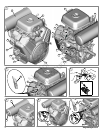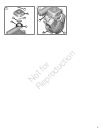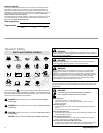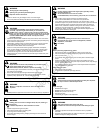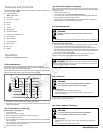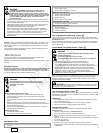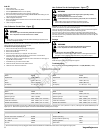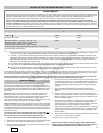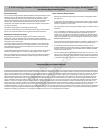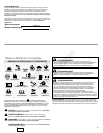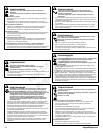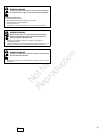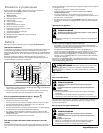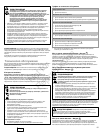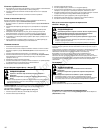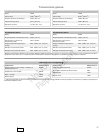
10 VanguardEngines.com
U.S. EPA, and Briggs & Stratton Corporation Emissions Control Warranty Statement for Emergency Standby Engines
Your Warranty Rights And Obligations
February 2013
General Information
The U.S. EPA, and Briggs & Stratton (B&S) are pleased to explain the emissions control
system warranty on your Model Year 2013 and later engine / equipment. In the U.S.,
new Emergency Standby Engines must be designed, built, and equipped to meet
stringent emission standards. Engines less than 25 Hp must meet requirements of 40
CFR Part 1054. Engines greater than 25 Hp and less than 130 Hp must meet
requirements of 40 CFR Part 1048. B&S must warrant the emissions control system on
your engine / equipment.
See Definition of appropriate use of Emergency Standby below.
The emission--related warranty covers all components whose failure would increase an
engine’s non--evaporative emissions of any regulated pollutant referenced below.
Manufacturer’s Warranty Coverage:
Briggs & Stratton warrants that the engine is free from defects in material and
workmanship, and is also designed, built, and equipped to conform to applicable
regulations under Section 213 of the Clean Air Act, from t he time the engine is sold, until
the expiration of its warranty period.
This warranty applies to all emission related engine components whose failure would
cause engine exhaust emissions to be out of EPA compliance. Further, this warranty
also applies to other engine components damaged due to the failure of any of these
emissions related components.
If a warrantable emissions related component on your engine is defective, the part will be
repaired or replaced by B&S at no cost to you including diagnosis, parts, and labor.
Warranty coverage period is four years from date of original purchase, and is offered to
the original purchaser and each subsequent purchaser so long as Owner’s Warranty
Responsibilities are adhered to.
Owner’s Warranty Responsibilities:
Warranty claims s hall be filed according to the provisions of the Briggs & Stratton
Warranty Policy.
An engine may not be warrantable if subjected to abuse, misuse, neglect, improper
maintenance, unapproved modifications, accidents not caused by Briggs & Stratton
engines or equipment, or by acts of God.
Only those engines used as an Emergency Stationary Engine, as defined below, are
warrantable.
You are responsible for presenting your engine / equipment to a B&S distribution
center, servicing dealer, or other equivalent entity, as applicable, as soon as a
problem exists. The warranty repairs should be completed in a reasonable amount
of time, not to exceed 30 days. If you have any questions regarding your warranty
rights and responsibilities, you should contact B&S at 1--800--233--3723 (in USA) or
BRIGGSandSTRATTON.COM.
If any components not scheduled for maintenance is repaired or replaced under this
warranty, the new part will be warranted only for the remaining warranty period.
If a warrantable component scheduled for maintenance fails prior to its first
scheduled replacement, the part will be repaired or replaced by B&S at no charge to
the owner. Any such component is only warrantable until the originally scheduled
maintenance period has expired.
Add on or modified parts that are not exempted by the EPA may not be used. The
use of any non--exempted add on or modified parts by the owner will be grounds for
disallowing a warranty claim. The manufacturer will not be liable to warrant failures
or warranted parts caused by the use of a non--exempted add on or modified part.
Emergency Stationary Engine Definition
An Emergency Stationary Engine is defined as any stationary internal combustion engine whose operation is limited to emergency situations and required testing and maintenance.
Examples include stationary engines used to produce power for critical networks or equipment (including power supplied to portions of a facility) when electric power from the local
utility (or the normal power source, if the facility runs on its own power production) is interrupted, or stationary engines used to pump water in the case of fire or flood, etc. Stationary
engines used for peak shaving are not considered emergency stationary engines. Stationary engines used to supply power to an electric grid or that supply power as part of a
financial arrangement with another entity are not considered to be emergency engines. Emergency s tati onary ICE may be operated for the purpose of maintenance checks and
readiness testing, provided that the tests are recommended by Federal, State or local government, the manufacturer, the vendor, or the insurance company associated with the
engine. Maintenance checks and readiness testing of such units is limited to 100 hours per year. There is no time limit on the use of emergency stationary engines in emergency
situations. The owner or operator may petition the Administrator for approval of additional hours to be used for maintenance checks and readiness testing, but a petition is not
required if the owner or operator maintains records indicating that Federal, State, or local standards require maintenance and testing of emergency ICE beyond 100 hours per year.
Emergency stationary ICE may operate up to 50 hours per year in non--emergency situations, but those 50 hours are counted towards the 100 hours per year provided for
maintenance and testing. The 50 hours per year for non--emergency situations cannot be used for peak shaving or to generate income for a facility to supply power to an electric grid
or otherwise supply power as part of a financial arrangement with another entity. For owners and operators of emergency engines, any operation other than emergency operation,
maintenance and testing, and operation in non--emergency situations for 50 hours per year, as permitted above is prohibited.
Not for
Reproduction



